SMA Adjustable Aspheric Collimators

- Collimate Light Exiting SMA-Terminated Fiber
- Low Beam Pointing Error During Adjustment
- Diffraction-Limited Performance
- Available Focal Lengths: 2.0 mm, 4.6 mm, 7.5 mm, and 11.0 mm
CFCS2-A
f = 2.0 mm,
350 - 700 nm
(Back View)
CFCS5-B
f = 4.6 mm,
650 - 1050 nm
(Front View)
CFCS8-C
f = 7.5 mm,
1050 - 1620 nm
(Front View)
Adjustable Aspheric Collimator with an SMA Receptacle

Please Wait
Design Improvements
We recently redesigned these adjustable fiber collimators for better performance. Improvements include:
- Tighter Dimensional Tolerances for Improved Pointing Stability
- Custom-Machined Threading for Accurate, Precise Positioning
- Locking Ring Applies Force More Evenly Than Locking Setscrew
- Captive Lens Cell
Features
- Collimate Light in Fiber-to-Free Space Applications
- Four Focal Length Options: 2.0 mm, 4.6 mm, 7.5 mm, and 11.0 mm
- Three AR-Coated Aspheric Lens Options:
- 350 - 700 nm
- 650 - 1050 nm (600 - 1050 nm for CFCS2-B)
- 1050 - 1620 nm (1050 - 1700 nm for CFCS2-C)
- SMA Receptacle
- Diffraction-Limited Performance when Used with Compatible Connector (See Tables Below)
- Pointing Error of <15 mrad During Adjustment
Thorlabs' Adjustable Focus Collimators for SMA-Terminated Fibers consist of a spring-loaded, AR-coated aspheric lens mounted inside a stainless steel cell. They are designed to collimate light exiting a fiber; for fiber-to-fiber coupling, we recommend using our Fiber Ports or a fiber launch nanopositioning stage.
Rotation of the outer barrel of the collimator leads to non-rotating translation of the housed aspheric lens along the optical axis, making it possible to adjust the distance between the lens and the tip of the fiber (see the Fiber-to-Lens Distance specification in the tables below). The dark band on the threading, shown on the bottom left, indicates the farthest recommended position of the outer barrel; adjusting the collimator beyond this position will lead to decreased performance outside of the guaranteed specifications. Once the desired position is reached, the adjustment can be locked into place using the knurled locking ring on the outside of the housing. See the animation to the right for usage instructions.
These collimators feature a non-rotating lens cell, and the adjustment mechanism is designed to minimize beam pointing error. Pointing stability is within <15 mrad for 2.0 mm focal length collimators, <5 mrad for 4.6 mm, 7.5 mm focal length collimators, and <1 mrad for 11.0 mm focal length collimators. Please see the below for complete specifications.
Thorlabs offers Single Mode (SM) and Multimode (MM) Hybrid Fiber Patch Cables with an SMA connector on one end and an FC/PC or FC/APC connector on the other. These cables simplify connections at interfaces in fiber applications. In addition to our stocked offerings, custom cables with SMA connectors are also available.
The collimators can be mounted by securing the Ø15 mm section of their housings in AD15F2 collimator adapters, as shown in the image below. The adapter's external SM1 (1.035"-40) threads allow it to be integrated with our wide selection of SM1- threaded optomechanics.
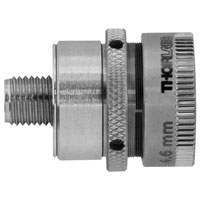
Click to Enlarge
The adjustable collimators have a dark band on the threading to indicate the limit of the collimator's specified adjustment range. Pointing stability and other stated specifications are not valid when the collimator is extended past this region.
| New Item # Prefix | New Pointing Stability | Former-Generation Item # Prefix | Former-Generation Pointing Stability |
|---|---|---|---|
| CFCS2 | <15 mrad | CFC-2X | >50 mrad (Typ.) |
| CFCS5 | <5 mrad | CFC-5X | >15 mrad (Typ.) |
| CFCS8 | <5 mrad | CFC-8X | >7 mrad (Typ.) |
| CFCS11 | <1 mrad | CFC-11X | >2 mrad (Typ.) |
Improved Pointing Stability
We redesigned our adjustable fiber collimators to minimize beam pointing error. By carefully controlling the dimensional tolerances, we were able to improve the pointing stability significantly, as shown in the table to the right. Standard metal-to-metal contact points will wear down over time; we selected specific materials with high galling resistance to mitigate this effect and ensure long-term stability. Using our in-house machining capabilities, we designed a special adjuster threading for high resolution, superior centration, and minimal backlash. Lastly, we locked the lens cell to prevent any pitch or yaw movements during adjustment.
Improved Locking Hysteresis
Former-generation adjustable fiber collimators used a locking setscrew to secure the position of the outer barrel and fix the lens position. This design applied unnecessary transverse force on the lens cell, leading to misalignment and greater pointing error. The redesigned collimators use a locking ring that applies force uniformly over the rotating barrel, thus maintaining the beam pointing stability.
The graphs below show the reflectance with respect to wavelength of the AR coatings used on the aspheric lenses in our adjustable fiber collimators. Reflectance values are per surface.
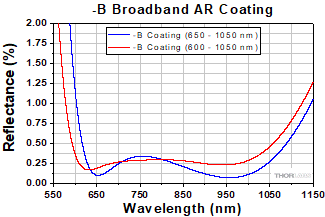
Click to Enlarge
Click Here to Download Raw Data
See the tables below for more information about the AR coating wavelength range that applies to each fiber collimator.
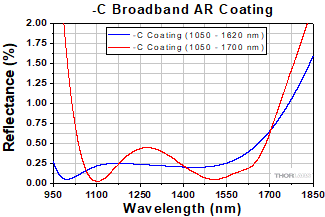
Click to Enlarge
Click Here to Download the Raw Data
See the tables below for more information about the AR coating wavelength range that applies to each fiber collimator.
The graphs below illustrate the theoretical 1/e2 beam diameter as a function of propagation distance at the specified wavelengths using our adjustable fiber collimators adjusted for the minimum divergence. Note that the beam diameter depends on the physical properties of the aspheric lens, such as focal length and NA, and is independent of the AR coating.
Theoretical Approximation of the Divergence Angle
The full-angle beam divergence listed in the specifications tables is the theoretically-calculated value associated with the fiber collimator. This divergence angle is easy to approximate theoretically using the formula below as long as the light emerging from the fiber has a Gaussian intensity profile. Consequently, the formula works well for single mode fibers, but it will underestimate the divergence angle for multimode (MM) fibers since the light emerging from an MM fiber has a non-Gaussian intensity profile.
The Full Divergence Angle (in degrees) is given by

where MFD is the mode field diameter and f is the focal length of the collimator. (Note: MFD and f must have the same units in this equation).
Example:
In this example, the CFCS2-A collimator with f = 2.0 mm is used with the P2-460B-PCSMA-1 single mode patch cable, which has an MFD = 2.8 - 4.1 µm at 488 nm. For the purposes of this example calculation, we will use the average of the MFD range (3.5 µm) which yields a divergence angle of
θ ≈ (0.0035 mm / 2.0 mm) * (180/3.1416) ≈ 0.100° or 1.75 mrad.
Theoretical Approximation of the Output Beam Diameter
The output beam diameter can be approximated from

where λ is the wavelength of light being used, MFD is the mode field diameter, and f is the focal length of the collimator.
Example:
When the CFCS5-C collimator (f = 4.6 mm) is used with the P2-SMF28-PCSMA-1 patch cable (with an average MFD = 10.4 µm) and 1550 nm light, the output beam diameter is
4 * (1550 nm) * [4.6 mm / (π · 10.4 µm)] = 0.87 mm
Theoretical Approximation of the Maximum Waist Distance
The maximum waist distance, which is the furthest distance from the lens the waist can be located in order to maintain collimation, may be approximated by:

where f is the focal length of the collimator, λ is the wavelength of light used, and MFD is the mode field diameter.
Example:
In this example, the CFCS2-A collimator with f = 2.0 mm is used with the P2-460B-PCSMA-1 single mode patch cable, which has an MFD = 2.8 - 4.1 µm at 488 nm. For the purposes of this example, we will use the average of the MFD range (3.5 µm) and calculate the maximum waist distance for a 488 nm beam:
(2 mm) + (2 * (2 mm)2 * (488 nm) / (3.1416) * (3.5 µm)2) = 103 mm.
Insights into Beam Characterization
Scroll down to read about:
- Beam Size Measurement Using a Chopper Wheel
Click here for more insights into lab practices and equipment.
Beam Size Measurement Using a Chopper Wheel
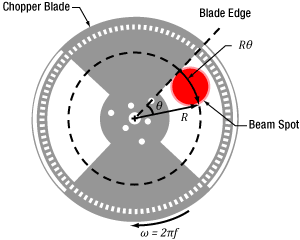
Click to Enlarge
Figure 2: The blade traces an arc length of Rθ through the center of the beam and has an angular rotation rate of  f. The chopper wheel shown is MC1F2.
f. The chopper wheel shown is MC1F2.
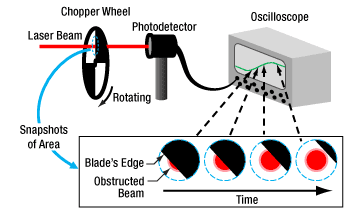
Click to Enlarge
Figure 1: An approximate measurement of beam size can be found using the illustrated setup. As the blade of the chopper wheel passes through the beam, an S-curve is traced out on the oscilloscope.
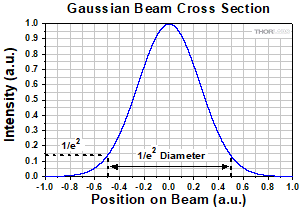
Click to Enlarge
Figure 4: The diameter of a Gaussian beam is often given in terms of the 1/e2 full width.
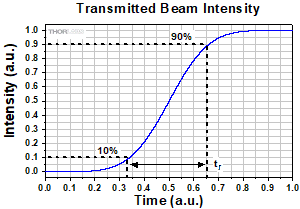
Click to Enlarge
Figure 3: Rise time (tr ) of the intensity signal is typically measured between the 10% and 90% points on the curve. The rise time depends on the wheel's rotation rate and the beam diameter.
Camera and scanning-slit beam profilers are tools for characterizing beam size and shape, but these instruments cannot provide an accurate measurement if the beam size is too small or the wavelength is outside of the operating range.
A chopper wheel, photodetector, and oscilloscope can provide an approximate measurement of the beam size (Figure 1). As the rotating chopper wheel's blade passes through the beam, an S-shaped trace is displayed on the oscilloscope.
When the blade sweeps through the angle θ , the rise or fall time of the S-curve is proportional to the size of the beam along the direction of the blade's travel (Figure 2). A point on the blade located a distance R from the center of the wheel sweeps through an arc length (Rθ ) that is approximately equal to the size of the beam along this direction.
To make this beam size measurement, the combined response of the detector and oscilloscope should be much faster than the signal's rate of change.
Example: S-Curve with Rising Edge
The angle  ftr )
ftr ) ftr )
ftr )

includes a factor of 1.56, which accounts for the portion of the beam measured between the 10% and 90% intensity points being smaller than the 1/e2 beam diameter.
Date of Last Edit: June 22, 2021
Content improved by our readers!
| Posted Comments: | |
| No Comments Posted |
Fiber Collimator Selection Guide
Click on the collimator type or photo to view more information about each type of collimator.
| Type | Description | |
|---|---|---|
| Fixed FC, APC, or SMA Fiber Collimators | 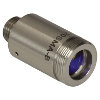 |
These fiber collimation packages are pre-aligned to collimate light from an FC/PC-, FC/APC-, or SMA-terminated fiber. Each collimation package is factory aligned to provide diffraction-limited performance for wavelengths ranging from 405 nm to 4.55 µm. Although it is possible to use the collimator at detuned wavelengths, they will only perform optimally at the design wavelength due to chromatic aberration, which causes the effective focal length of the aspheric lens to have a wavelength dependence. |
| Air-Spaced Doublet, Large Beam Collimators | 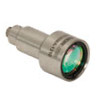 |
For large beam diameters (Ø5.3 - Ø8.5 mm), Thorlabs offers FC/APC, FC/PC, and SMA air-spaced doublet collimators. These collimation packages are pre-aligned at the factory to collimate a laser beam propagating from the tip of an FC or SMA-terminated fiber and provide diffraction-limited performance at the design wavelength. |
| Triplet Collimators | 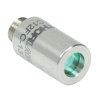 |
Thorlabs' High Quality Triplet Fiber Collimation packages use air-spaced triplet lenses that offer superior beam quality performance when compared to aspheric lens collimators. The benefits of the low-aberration triplet design include an M2 term closer to 1 (Gaussian), less divergence, and less wavefront error. |
| Achromatic Collimators for Multimode Fiber | 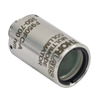 |
Thorlabs' High-NA Achromatic Collimators pair a meniscus lens with an achromatic doublet for high performance across the visible to near-infrared spectrum with low spherical aberration. Designed for use with high-NA multimode fiber, these collimators are ideal for Optogenetics and Fiber Photometry applications. |
| Reflective Collimators |  |
Thorlabs' metallic-coated Reflective Collimators are based on a 90° off-axis parabolic mirror. Mirrors, unlike lenses, have a focal length that remains constant over a broad wavelength range. Due to this intrinsic property, a parabolic mirror collimator does not need to be adjusted to accommodate various wavelengths of light, making them ideal for use with polychromatic light. Our fixed reflective collimators are recommended for collimating single and multimode fiber and coupling into multimode fiber. These collimators are available with UV-enhanced aluminum or protected silver reflective coatings and with FC/PC, FC/APC, or SMA connector compatibility. |
| Compact Reflective Collimators | 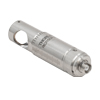 |
Thorlabs' Compact Reflective Collimators incorporate a 90° off-axis parabolic mirror with a protected silver coating. Because the focal length is independent of wavelength for an off-axis parabolic mirror, they are ideal for use with polychromatic light. Our fixed reflective collimators are recommended for collimating single and multimode fiber and coupling into multimode fiber. These collimators are directly compatible with our 16 mm cage system. They are available with FC/PC, FC/APC, or SMA connector inputs. |
| Adjustable Reflective Collimators | 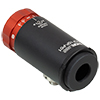 |
Thorlabs' Adjustable Focus Reflective Collimators are based on a 90° off-axis parabolic (OAP) mirror with a protected silver coating. The adjustable fiber-to-OAP distance, combined with the OAP having a constant focal length across wavelengths, makes these collimators ideal for optimizing collimation or coupling of polychromatic light with single mode or multimode fiber. These adjustable collimators have a 15 mm reflected focal length and are available with FC/PC, FC/APC, or SMA connectors. |
| FiberPorts | 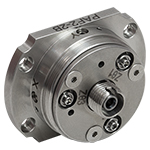 |
These compact, ultra-stable FiberPort micropositioners provide an easy-to-use, stable platform for coupling light into and out of FC/PC, FC/APC, or SMA terminated optical fibers. It can be used with single mode, multimode, or PM fibers and can be mounted onto a post, stage, platform, or laser. The built-in aspheric or achromatic lens is available with five different AR coatings and has five degrees of alignment adjustment (3 translational and 2 pitch). The compact size and long-term alignment stability make the FiberPort an ideal solution for fiber coupling, collimation, or incorporation into OEM systems. |
| Adjustable Fiber Collimators |  |
These collimators are designed to connect onto the end of an FC/PC, FC/APC, or SMA connector and contain an AR-coated aspheric lens. The distance between the aspheric lens and the tip of the fiber can be adjusted to compensate for focal length changes or to recollimate the beam at the wavelength and distance of interest. |
| Achromatic Fiber Collimators with Adjustable Focus |  |
Thorlabs' Achromatic Fiber Collimators with Adjustable Focus are designed with an effective focal length (EFL) of 20 mm, 40 mm, or 80 mm, have optical elements broadband AR coated for one of three wavelength ranges, and are available with FC/PC, FC/APC, or SMA905 connectors. A four-element, air-spaced lens design produces superior beam quality (M2 close to 1) and less wavefront error when compared to aspheric lens collimators. These collimators can be used for free-space coupling into a fiber, collimation of output from a fiber, or in pairs for collimator-to-collimator coupling over long distances, which allows the beam to be manipulated prior to entering the second collimator. |
| Zoom Fiber Collimators | 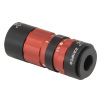 |
These collimators provide a variable focal length between 6 and 18 mm, while maintaining the collimation of the beam. As a result, the size of the beam can be changed without altering the collimation. This universal device saves time previously spent searching for the best suited fixed fiber collimator and has a very broad range of applications. They are offered with FC/PC, FC/APC, or SMA905 connectors with three different antireflection wavelength ranges to choose from. |
| Single Mode Pigtailed Collimators | 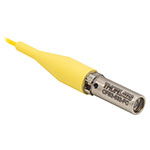 |
Our single mode pigtailed collimators come with one meter of fiber, consist of an AR-coated aspheric lens pre-aligned with respect to a fiber, and are collimated at one of eight wavelengths: 532 nm, 633 nm, 780 nm, 850 nm, 1030 nm, 1064 nm, 1310 nm, or 1550 nm. Although it is possible to use the collimator at any wavelength within the coating range, the coupling loss will increase as the wavelength is detuned from the design wavelength. |
| Polarization Maintaining Pigtailed Collimators | 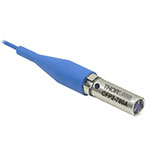 |
Our polarization maintaining pigtailed collimators come with one meter of fiber, consist of an AR-coated aspheric lens pre-aligned with respect to a fiber, and are collimated at one of five wavelengths: 633 nm, 780 nm, 980 nm, 1064 nm, or 1550 nm. Custom wavelengths and connectors are available as well. A line is engraved along the outside of the housing that is parallel to the fast axis. As such, it can be used as a reference when polarized light is launched accordingly. Although it is possible to use the collimator at any wavelength within the coating range, the coupling loss will increase as the wavelength is detuned from the design wavelength. |
| GRIN Fiber Collimators | 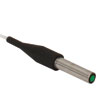 |
Thorlabs offers gradient index (GRIN) fiber collimators that are aligned at a variety of wavelengths from 630 to 1550 nm and have either FC terminated, APC terminated, or unterminated fibers. Our GRIN collimators feature a Ø1.8 mm clear aperture, are AR-coated to ensure low back reflection into the fiber, and are coupled to standard single mode or graded-index multimode fibers. |
| GRIN Lenses | 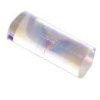 |
These graded-index (GRIN) lenses are AR coated for applications at 630, 830, 1060, 1300, or 1560 nm that require light to propagate through one fiber, then through a free-space optical system, and finally back into another fiber. They are also useful for coupling light from laser diodes into fibers, coupling the output of a fiber into a detector, or collimating laser light. Our GRIN lenses are designed to be used with our Pigtailed Glass Ferrules and GRIN/Ferrule sleeves. |

| Item # | f (mm) |
NAa | Input MFDb |
Output Waist Diameter (1/e2) |
Max Waist Distancec |
Pointing Stability During Collimation |
Divergenced | Fiber-to-Lens Distancee |
AR Coatingf | Compatible Connector |
|---|---|---|---|---|---|---|---|---|---|---|
| CFCS2-A | 2.0 | 0.5 | 3.5 µm | 0.36 mmg | 103.4 mmg | <15 mrad | 0.100°g | 0.4 - 3.0 mm | 350 - 700 nm | SMA |
| CFCS2-B | 2.0 | 0.5 | 5.0 µm | 0.43 mmh | 88.6 mmh | <15 mrad | 0.143°h | 0.4 - 3.0 mm | 600 - 1050 nm | |
| CFCS2-C | 2.0 | 0.5 | 10.4 µm | 0.38 mmi | 38.5 mmi | <15 mrad | 0.298°i | 0.4 - 3.0 mm | 1050 - 1700 nm |

| Item # | f (mm) |
NAa | Input MFDb |
Output Waist Diameter (1/e2) |
Max Waist Distancec |
Pointing Stability During Collimation |
Divergenced | Fiber-to-Lens Distancee |
AR Coatingf | Compatible Connector |
|---|---|---|---|---|---|---|---|---|---|---|
| CFCS5-A | 4.6 | 0.53 | 3.5 µm | 0.82 mmg | 541.2 mmg | <5 mrad | 0.044°g | 2.4 - 4.9 mm | 350 - 700 nm | SMA |
| CFCS5-B | 4.6 | 0.53 | 5.0 µm | 1.00 mmh | 462.6 mmh | <5 mrad | 0.062°h | 2.4 - 4.9 mm | 650 - 1050 nm | |
| CFCS5-C | 4.6 | 0.53 | 10.4 µm | 0.87 mmi | 197.7 mmi | <5 mrad | 0.130°i | 2.4 - 4.9 mm | 1050 - 1620 nm |

| Item # | f (mm) |
NAa | Input MFDb |
Output Waist Diameter (1/e2) |
Max Waist Distancec |
Pointing Stability During Collimation |
Divergenced | Fiber-to-Lens Distancee |
AR Coatingf | Compatible Connector |
|---|---|---|---|---|---|---|---|---|---|---|
| CFCS8-A | 7.5 | 0.3 | 3.5 μm | 1.33 mmg | 1434.1 mmg | <5 mrad | 0.027°g | 4.2 - 6.8 mm | 350 - 700 nm | SMA |
| CFCS8-B | 7.5 | 0.3 | 5.0 μm | 1.62 mmh | 1225.0 mmh | <5 mrad | 0.038°h | 4.2 - 6.8 mm | 650 - 1050 nm | |
| CFCS8-C | 7.5 | 0.3 | 10.4 μm | 1.42 mmi | 520.7 mmi | <5 mrad | 0.079°i | 4.2 - 6.8 mm | 1050 - 1620 nm |

| Item # | f (mm) |
NAa | Input MFDb |
Output Waist Diameter (1/e2) |
Max Waist Distancec |
Pointing Stability During Collimation |
Divergenced | Fiber-to-Lens Distancee |
AR Coatingf | Compatible Connector |
|---|---|---|---|---|---|---|---|---|---|---|
| CFCS11-A | 11.0 | 0.3 | 3.5 μm | 1.95 mmg | 3079.7 mmg | <1 mrad | 0.018°g | 8.6 - 10.9 mm | 350 - 700 nm | SMA |
| CFCS11-B | 11.0 | 0.3 | 5.0 μm | 2.38 mmh | 2630.1 mmh | <1 mrad | 0.026°h | 8.6 - 10.9 mm | 650 - 1050 nm | |
| CFCS11-C | 11.0 | 0.3 | 10.4 μm | 2.09 mmi | 1114.9 mmi | <1 mrad | 0.054°i | 8.6 - 10.9 mm | 1050 - 1620 nm |
 Products Home
Products Home












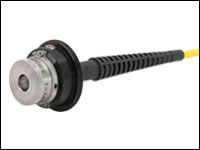
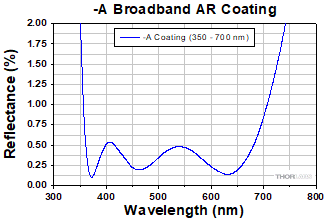
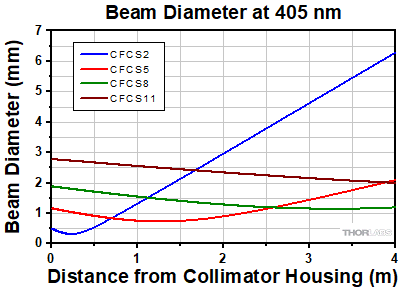
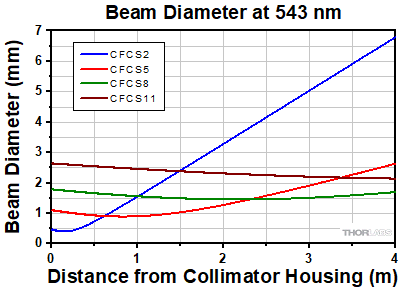
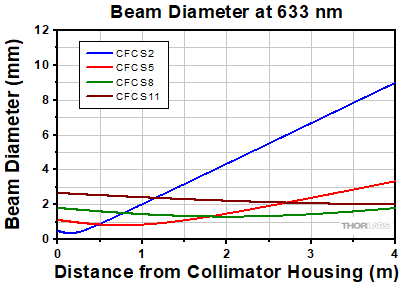
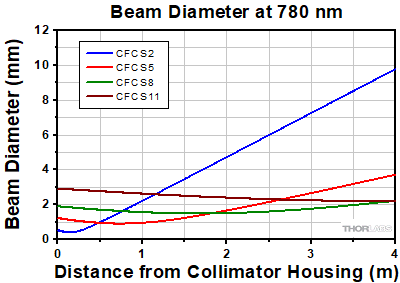
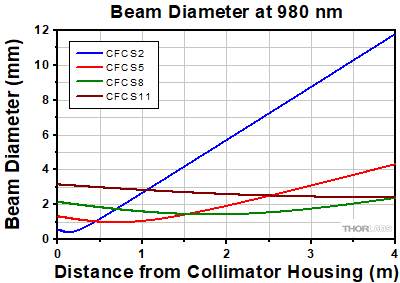
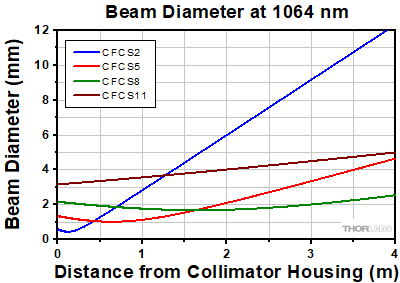
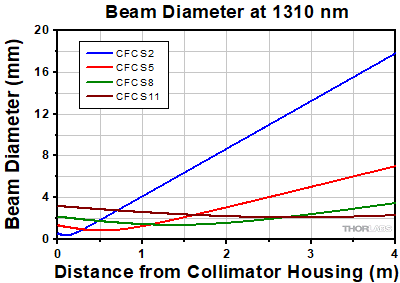
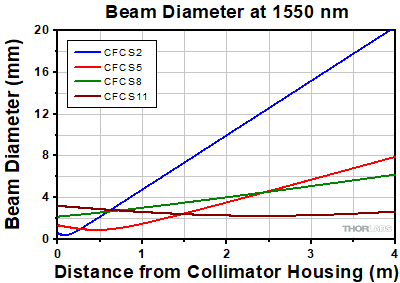

 SMA Adjustable Aspheric Collimators
SMA Adjustable Aspheric Collimators